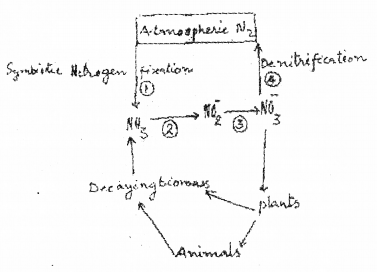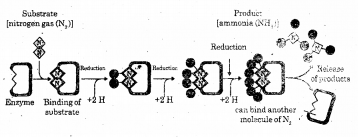Kerala Plus One Botany Chapter Wise Previous Questions Chapter 8 Mineral Nutrition
Question 1.
The nitrogenase enzyme and leghaemoglobin are two important compounds related to nitrogen fixation in plants. Mention the function of each. (MARCH-2010)
Answer:
Nitrogenase – It is an enzyme involved in the conversion of N2 to NH3
Leghaemoglobin – It is the pink coloured pigment act as an 02 scavenger i.e it helps to prevent the combining of nitrogenase with 02
Question 2.
Observe the diagram and answer the following: (SAY-2010)

a) This is peculiar type of plant cultivation. Name it.
b) Aeration is necessary for the conduct of this type of cultivation. Why?
Answer:
a) Hydroponics
b) 02 supply is needed for the optimum growth of plants/absorption of nutrients
Question 3.
Macronutrients and micronutrients are found to be absolutely essential for plant growth and metabolism.
Name two macronutrients. (MARCH-2011)
Answer:
Carbon, Hydrogen
Question 4.
Reduction of nitrogen to ammonia by living organisms is called bilogical nitrogen fixation. Can you write about one free living nitrogen fixing aerobic microbe? (SAY-2011)
Answer:
Azotobactor
Question 5.
In the given flow chart of N2 cycle write the name of organisms involved in the numbered places. (SAY-2011)

Answer:
Rhizobium
nitrococcus
nitrobactor
Thiobacillus
Question 6.
a) Carotenoids are responsible for the pink colour of root nodule in pea plant. (MARCH-2012)
Correct this false statement.
b) The pigment present in root nodule is called, ‘Oxygen scavenger’. Justify.
Answer:
a) Leg – haemoglobin
b) Leg – haemoglobin which protect nitrogenase enzyme and it act as oxygen scavenger.
Question 7.
The biochemical assay of some plants indicates the presence of Gold, Vanadium, Silicon etc. But, these elements are not considered as essential elements. Comment. (SAY-2012)
Answer:
1) Essential elements required for normal growth and development.
2) Role of essential element is specific ie, not replaced by another element. Hence gold, Vanadium, Silicon etc. are not considered as essential elements.
Question 8.
‘In a plant, deficiency of N2 is visible in older parts and that of Ca is visible in younger parts’. Critically evaluate the statement. (SAY-2012)
Answer:
N2 is a mobile element which move from older parts to younger parts
Ca is an immobile element .which cannot move. Hence deficiency symptoms are found in younger parts
Question 9.
Nitrogen in the atmosphere exist as N2 (N = N). But it cannot be absorbed by plants as such. So it converted into ammonia (NH3) by microorganisms and get fixed in the soil. (SAY-2013)
a) Name the enzyme in the microorganisms which help to convert nitrogen into ammonia.
b) What is the role of leg-haemoglobin in this process?
Answer:
a) Nitrogenase
b) It act as 02 scavenger that means it helps in preventing the combining of 02 with nitrogenase
Question 10.
The deficiency symptoms of macro elements like calcium tend to appear first in the young tissues. Why? (MARCH-2014)
Answer:
It is an immobile element. So it cannot move to younger regions of plant.
Question 11.
Ammonia is first oxidizied to nitrite and the nitrite is further oxidized to nitrate. Name the process. Give any one example of a bacterium which is involved in this process. (MARCH-2014)
Answer:
Nitrification, Ammonia is converted into nitrite with help of nitrosomonas but nitrite is converted into nitrate by nitrobactor.
Question 12.
If you cut through the root nodules of a pea plant, you will notice that the central portion is red or pink. (MARCH-2014)
a) What makes the nodule pink?
b) Mention the role of this pink pigment.
Answer:
a) Leghaemoglobin
b)lt act as 02 scavenger that means it helps in preventing the combining of 02 with nitrogenase.
Question 13.
Observe the diagram given below. (SAY-2014)

a) Name this technique
b) Write two advantages of this technique
Answer:
a) Hydroponics
b) 1. It helps in studying deficiency symptoms
2. It is useful for the Commercial production of vegetables such as tomato.
Question 14.
Even though more than sixty elements are found in different plants, all are not essential. Write any two criteria for the essentiality of an element. (MARCH-2015)
Answer:
1) The element must be absolutely necessary for supporting normal growth and reproduction.
2) The requirement of the element must be specific and not replaceable by another element.
Question 15.
Steps of conversion of atmospheric Nitrogen to Ammonia by Nitrogen fixing bacteria are given below. (SAY-2015)

Name the key enzyme in that reaction and point out the relationship between the key enzyme and leg- hemoglobin.
Answer:
key enzyme in nitrogen fixation is Nitrogenase. Leghaemoglobin is the pigment protect nitrogenase from the activity of oxygen.
Question 16.
The plants show deficiency symptoms when the concentration of an essential element is below the critical concentration. Write any four deficiency symptoms shown by plants. (MARCH-2016)
Answer:
chlorosis, necrosis, delay flowering and inhibition of cell division.
Question 17.
About 16 elements are found to be needed for the normal growth and development in plants. Mention the three important criteria for the essentiality of an element and the metalic element forming the structural component of chlorophyll molecule. (SAY-2016)
Answer:
1) The element must be essential for normal growth and reproduction.
2) Role of element must be specific, not replaced by other element.
3) Element is directly involved in the metabolism of the plant. Mg(Magnesium) forms the structural component of Chlorophyll
Question 18.
The root nodules of leguminous plants contain two necessary biochemical compounds for N2 fixation. Identify these compounds. (MARCH-2017)
Answer:
Nitrogenase enzyme
Leg-haemoglobin